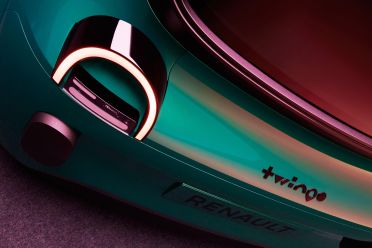The rumours from the last few days are correct, the Renault Twingo is coming back as a retro-styled affordable electric city car.
Overnight the French automaker unveiled the Twingo Legend concept during its capital markets day for its Ampere division.
Like the upcoming Renault 5 hatch and Renault 4 crossover, the new Twingo will mine the company’s past to secure its future.
Styled to resemble the first-generation Twingo, the concept for the fourth-generation car features a two-box silhouette remarkably similar to the original. Like the original it has semi-circular head- and tail-lights, vertical handles for the front doors, and a prominent frame around the rear windshield.
The concept also features three black pods on the top of the bonnet, which are a call back to the original car’s hood vents. Given the new Twingo’s electric drivetrain, bonnet vents aren’t required, so these pods house a set of airport-style flipper displays to show the vehicle’s battery status.
While the first- and second-generation Twingos were three-door hatchbacks, the new model will have a more practical five-door body, with the handles for the rear doors hidden in the window trim.
According to Automotive News Europe, Renault CEO Luca de Meo told investors and the press the new Twingo will be developed in a “record” two years in order to match the speed of Chinese automakers.
The Renault chief also said the new Twingo is a “response to a lot of issues, challenges and paradoxes that we have to master”.
These include the rise of Chinese automakers, which have big inroads into both the European and Australian markets with affordable EVs, environmental sustainability, and the sourcing of components required for batteries and motors.
Perhaps Renault’s biggest challenge is figuring out how to make city cars profitable. Most European automakers have been backing out of the segment, preferring to concentrate on larger segments where margins are fatter, and buyers less price sensitive.
It’s said the new Twingo will have a starting price under €20,000 ($33,000), placing it at the entry point to Renault’s EV range where the Renault 5 is planned to start from €25,000 ($42,000).
Despite this price guidance, the new Europe-designed and built Twingo won’t be the cheapest EV offered by the Renault family. That honour will likely still belong to the €15,800 ($26,500) 33kW Dacia Spring imported from China
For reference, the current Twingo EV is priced from €20,250 ($34,000) in France, and has a 60kW/180Nm electric motor driving the rear wheels.
It is fitted with a 22kWh battery located under the front seats, and has a claimed WLTP range of 190km. While the Twingo EV doesn’t work with DC fast charging, it does support AC charging up to 11kW
It’s unclear if the new Twingo will use an existing EV platform, or whether it will form the basis for something new. According to de Meo, Renault is planning to launch a “software defined vehicle” in 2026, which is when the new Twingo is reportedly due to start rolling out of the company’s Novo Mesto plant in Slovenia.
The software-led vehicle design philosophy is claimed to reduce development times, as well as complexity and cost. All of which Renault will need to achieve in order to make the production Twingo appear on time, and profitable.
Details about the fourth-generation Twingo’s drivetrain are predictably scant, but Renault claims the new EV will have “best-in-class” efficiency of around 10kWh per 100 kilometres.
Luca de Meo described the new Twingo as a “a very intelligent concept”, and a “European kei car”. He said Renault is sticking with smaller cars was because it “doesn’t make sense to use a 2.5 tonne car to move a single person in the city”.
Renault currently has two EV platforms available. There’s AmpR Medium — previously referred to as Renault-Nissan-Mitsubishi Alliance’s CMF-EV architecture — which currently underpins the Renault Megane E-Tech and Nissan Ariya, and the upcoming Scenic E-Tech.
There’s also the smaller AmpR Small architecture — previously known as the Alliance’s CMF-BEV platform — that will be used in the upcoming Renault 4 crossover, and Renault 5 hatchback.






